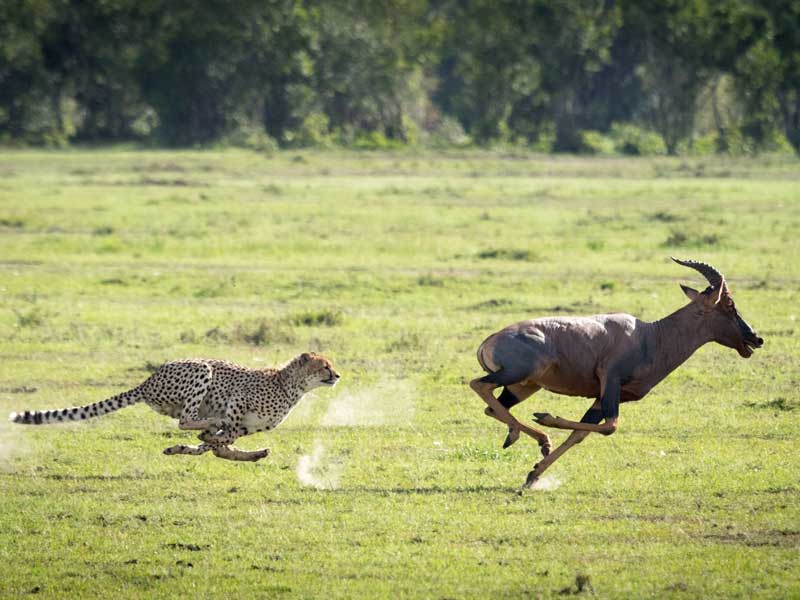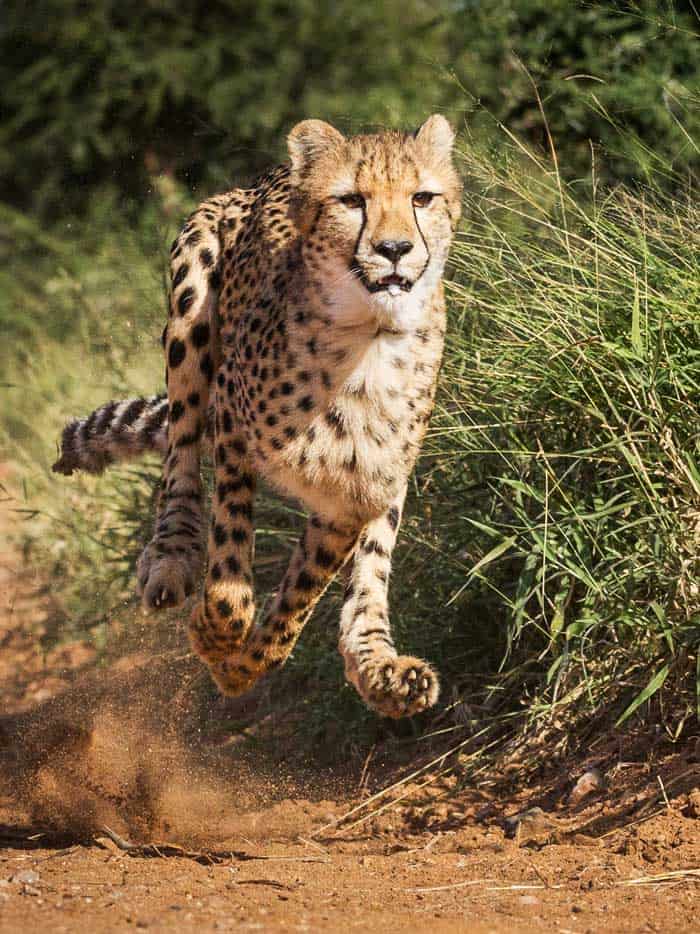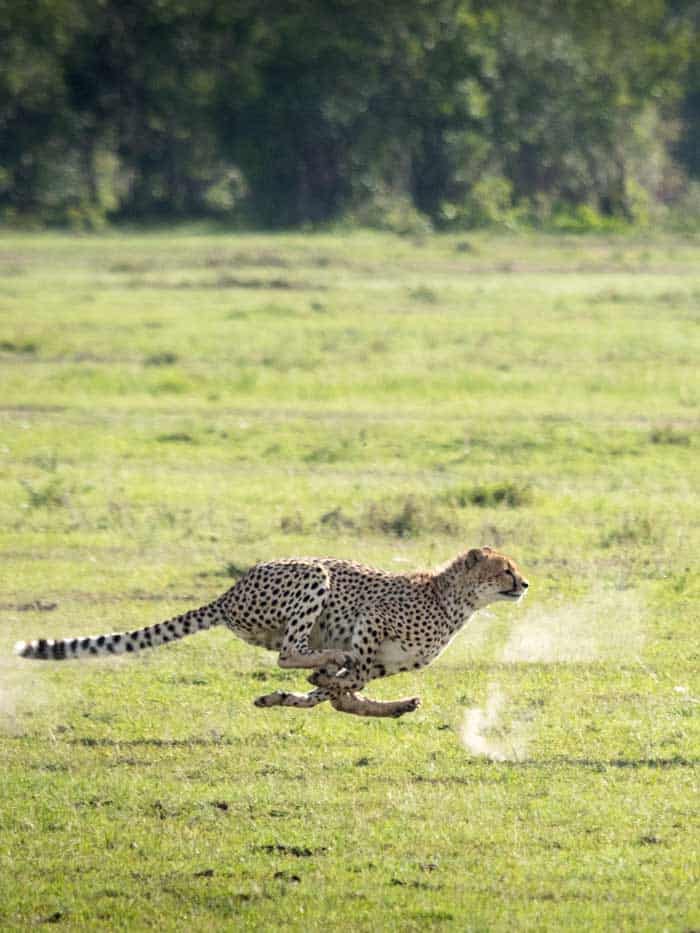How Fast Can a Cheetah Run? Top Speed, 6 Unique Features
Cheetahs are the fastest land animal in the world! Just how fast can a cheetah run? What are their top speeds? In this post, you’ll learn their top and average speed, plus unique features that allow them to run so fast.

Cheetah Top and Average Speeds
Cheetahs are capable of running an amazing top speed of 76 mph (122 km/h)! But this is only sustainable for a short sprint (1480 feet). And this speed is only a calculated speed.
Cheetahs average speed is just 40 mph (64 km/h) but can quickly accelerate to its top speed.
Fastest Cheetah Recorded
The fastest recorded speed was by a cheetah named Sarah. Sarah the cheetah was recorded doing a top speed of 61 mph (98 km/h) during a 100-meter dash while living at the Cincinnati Zoo in Ohio. Sadly, Sarah passed away in January 2016, at the old age of 15 (the average lifespan of a cheetah in the wild is 10-12 years).

6 Reasons Cheetahs Can Run So Fast
Cheetahs (Acinonyx jubatus) are built for speed. They have been compared to greyhounds in terms of similar builds.
Here are 6 reasons they are the fastest land animal:
- Cheetahs have long thin legs, a small head, and a flat rib cage. This helps with minimizing wind resistance. Despite being long and thin, their legs are powerful. Adult cheetahs can reach 160 lbs. and 4 ft 11 in long.
- Cheetah tails, which can get to 31 inches (80 cm) long, help the cheetahs’ speed by acting as a rudder to help steer and stabilize.
- For traction, cheetahs have hard footpads and blunt, semi-retractable claws which help them grip the ground. You can’t go fast if you can’t stay on your feet!
- More than just staying on their feet, a cheetah’s powerful strides mean that for more than half the time they’re running, all four paws are off the ground. This is is similar to other animals like horses and greyhounds.
- Another reason cheetahs are so speedy is because of their skeletal structure. With a flexible spine, flexible hips, and loose shoulder blades, cheetahs can store and release energy like springs.
- Cheetahs also have an enlarged heart and lungs, and large nasal passages. This means they can get more oxygen when they run, thus preventing them from getting out of breath quickly when going at breakneck speeds.
For all these reasons, then, it’s no wonder cheetahs are the fastest land animal on the earth!
How long can a cheetah maintain its top speed?
Cheetahs can’t maintain their top speed for very long. Cheetahs can run at top speed for around 0.28 miles (0.45 kilometers). They are more sprinters than long-distance runners. And they can cover that distance in just 13 seconds at top speed.
And cheetahs have an average running speed of 40 mph (64km/h).
Here’s how long a cheetah can run at top speeds. And how long it would take to cover the same distance at their average speed.
- 13 seconds at Top Speed (76 mph for 0.28 miles)
- 25 seconds at Average Speed (40 mph for 0.28 miles)
And here are the same specs in metric.
- 13 seconds at Top Speed (122 km/h for 0.45 kilometers)
- 25 seconds at Average Speed (64 km/h for 0.45 kilometers)
How fast can a cheetah accelerate?
Cheetahs can go from 0-60 mph (0-96.5km/h) in about 3 seconds! Cheetahs can accelerate very quickly.
This is a similar 0-60 time as the Ford GT, a USD$500,000 supercar. In fact, a cheetah’s acceleration time means it measures well compared to with world’s fastest cars.
(To be honest, I would rather a supercar than a cheetah. But hey, that’s just me.)
Cheetah deceleration
Just as impressive as their straight-line speed, cheetahs can also decelerate quickly. They can go from around 60 mph (97 km/h) to 14 mph (23 km/h) in three strides.
How does a cheetah measure up to other big cats?
Now that we’ve compared the cheetah to supercars, how do they stack up against other big cats? Let’s find out. The following are 8 of the fastest wild cats in the world and their top speeds:
- Jaguar (Panthera onca): 50 mph (80 km/h)
- Lion (Panther leo): 50 mph (80 km/h)
- Eurasian Lynx (Lynx lynx): 50 mph (80 km/h)
- Cougar (Puma concolor): 50 mph (80 km/h)
- Tiger (Panther tigris): 40 mph (64 km/h)
- Snow Leopard (Panthera uncia): 40 mph (64 km/h)
- Clouded Leopard (Neofelis nebulosa): 40 mph (64 km/h)
- Leopard (Panthera pardus): 36 mph (58 km/h)
All are fast and majestic, and can easily outrun a human. However, none of them can catch the cheetah’s either calculated top speed, or their recorded one.
Here’s how cheetahs compare to jaguars.
2 Reasons Cheetahs Run
Cheetahs are hunters. They use their speed to catch their prey. Cheetahs hunt small to medium prey, usually less than 88 pounds (40 kilograms). Larger prey are often avoided, and if cheetahs do attack a bigger target, they will generally do so in groups.
To escape: However, cheetahs are also among the smaller of the big cats, built for speed and less for power. Thus, they can be bullied from their kills. Lions, leopards, and hyenas can take their prey away from cheetahs. So, cheetahs have to eat their prey quickly, or else they have to use their speed for another reason, to escape.

How do cheetahs hunt?
Cheetahs will stalk their prey, often within 200-230 feet (60-70 meters). Cheetahs will also lay in wait for the prey to come nearer. If there isn’t any cover, then cheetahs will approach within 660 feet (220 meters), then spring their attack.
The chase usually lasts a minute, and cheetahs may give up they chase if they get detected by their prey or if they can’t kill their target quickly.
To catch the animal, cheetahs will try to trip their prey either with their dewclaw or by swatting at its rump. This may break the bones of the prospective meal, making it easier for cheetahs to catch it.
After catching their prey, cheetahs will bite at the prey’s neck to suffocate it, holding on for around 5 minutes. Smaller prey may die from the bite itself.
What time of day do cheetahs hunt?
Often, cheetahs will hunt during the daytime, usually around dawn (between 6am to 10 am) and dusk (between 4pm and 6 pm).
Cheetahs tend to avoid when other bigger creatures hunt, like lions (who primarily hunt at night). This makes sense, as they can avoid any confrontation with bigger and more powerful predators.
What type of prey do cheetahs hunt?
Cheetahs will hunt medium-sized ungulates, depending on the area. Cheetahs may prey on livestock as well. Their prey is often fast themselves, with gazelles and springboks able to get to speeds of 60 mph (96 km/h) and 55 mph respectively.
Here are some of the cheetah’s favorite prey: gazelles, springboks, impalas, and other small antelope.
Read more about the zebra’s top running speed.
How successful are cheetahs with their hunt?
The success rate cheetahs have with their hunts is 25 to 40 percent. If their prey is smaller, then it may be higher.
What happens after cheetahs hunt?
Cheetahs expend a lot of energy with their running. After the hunt is over and their food is caught, cheetahs may rest for up to an hour after dragging their kill to a tree or a bush.
Running that hard can tire anyone or anything out, so cheetahs can be found panting quite heavily after a run.

Learn about cheetah cubs: 14 Cute Baby Cheetah Facts
How Much Faster is a Cheetah Than a Human?
The quick answer is that cheetahs can outrun humans by a lot. Sarah the cheetah, mentioned earlier, did the 100-meter dash in 5.95 seconds, destroying Usain Bolt’s 100-meter record time of 9.58 seconds.
The average man can run 5.9 mph (9.5 km/h). At this speed, it would take the average man 38 seconds to run 100 meters, verses cheetahs 5.95 seconds.
Have cheetahs ever attacked humans?
There have not been many documented cases of a cheetah attacking a human. When an incident does happen, it’s usually because of an aggravated cheetah in captivity. In fact, they’re quite docile compared to other big cats. Cheetahs have also been known to purr!
Cheetahs have been tamed and kept as pets, and humans have done so for thousands of years. In fact, there are cheetah experiences in zoos around the world today where you can go pet and play with these lovable big cats.
Still, cheetahs don’t do well in captivity. In 2014, 23 percent of cheetahs in captivity around the world died before they reached the one-year-old mark.
More reading: Cheetah vs Leopard: 14 Key Differences

Keep Reading: 21 King Cheetah Facts
Your Turn!
What do you think about cheetahs? Ever hear one purr? Is there anything we missed? Let us know in the comments below!






